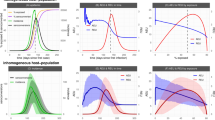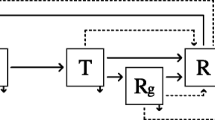Abstract
Human cases of hantavirus pulmonary syndrome caused by Sin Nombre virus are the endpoint of complex ecological cascade from weather conditions, population dynamics of deer mice, to prevalence of SNV in deer mice. Using population trajectories from the literature and mathematical modeling, we analyze the time lag between deer mouse population peaks and peaks in SNV antibody prevalence in deer mice. Because the virus is not transmitted vertically, rapid population growth can lead initially to reduced prevalence, but the resulting higher population size may later increase contact rates and generate increased prevalence. Incorporating these factors, the predicted time lag ranges from 0 to 18 months, and takes on larger values when host population size varies with a longer period or higher amplitude, when mean prevalence is low and when transmission is frequency-dependent. Population size variation due to variation in birth rates rather than death rates also increases the lag. Predicting future human outbreaks of hantavirus pulmonary syndrome may require taking these effects into account.
Similar content being viewed by others

References
Abbott, K.D., Ksiazek, T.G., Mills, J.N., 1999. Long-term hantavirus persistence in rodent populations in central Arizona. Emerg. Infect. Dis. 5, 102–112.
Abramson, G., Kenkre, V.M., 2002. Spatiotemporal patterns in the hantavirus infection. Phys. Rev. E 66, 011912.
Allen, L.J.S., McCormack, R.K., Johnson, C.B., 2006. Mathematical models for hantavirus infection in rodents. Bull. Math. Biol. 68, 511–524.
Anderson, R., May, R., 1992. Infectious Diseases of Humans. Oxford University Press, Oxford.
Barlow, N.D., 2000. Non-linear transmission and simple models for bovine tuberculosis. J. Animal Ecol. 69, 703–713.
Begon, M., Feore, S.M., Brown, K., Chantrey, J., Jones, T., Bennett, M., 1998. Population and transmission dynamics of cowpox in bank voles: testing fundamental assumptions. Ecol. Lett. 1, 82–86.
Biggs, J.R., Bennett, K.D., Mullen, M.A., Haarmann, T.K., Salisbury, M., Robinson, R.J., Keller, D., Torrez-Martinez, N., Hjelle, B., 2000. Relationship of ecological variables to Sin Nombre virus antibody seroprevalence in populations of deer mice. J. Mammal. 81, 676–682.
Boone, J.D., Otteson, E.W., McGwire, K.C., Villard, P., Rowe, J.E., Jeor, S.C.S., 1998. Ecology and demographics of hantavirus infections in rodent populations in the Walker River Basin of Nevada and California. Am. J. Trop. Med. Hyg. 59, 445–451.
Botten, J., Mirowsky, K., Ye, C.Y., Gottlieb, K., Saavedra, M., Ponce, L., Hjelle, B., 2002. Shedding and intracage transmission of Sin Nombre hantavirus in the deer mouse (Peromyscus maniculatus) model. J. Virol. 76, 7587–7594.
Brown, J.H., Ernest, S.K.M., 2002. Rain and rodents: complex dynamics of desert consumers. Bioscience 52, 979–987.
Buceta, J., Escudero, C., de la Rubia, F.J., Lindenberg, K., 2004. Outbreaks of hantavirus induced by seasonality. Phys. Rev. E 69, 021906.
Caley, P., Ramsey, D., 2001. Estimating disease transmission in wildlife, with emphasis on leptospirosis and bovine tuberculosis in possums, and effects of fertility control. J. Appl. Ecol. 38, 1362–1370.
Calisher, C.H., Sweeney, W., Mills, J.N., Beaty, B.J., 1999. Natural history of Sin Nombre virus in western Colorado. Emerg. Infect. Dis. 5, 126–134.
Calisher, C.H., Mills, J.N., Sweeney, W.P., Choate, J.R., Sharp, D.E., Canestorp, K.M., Beaty, B.J., 2001. Do unusual site-specific population dynamics of rodent reservoirs provide clues to the natural history of hantaviruses? J. Wild. Dis. 37, 280–288.
Calisher, C.H., Root, J.J., Mills, J.N., Rowe, J.E., Reeder, S.A., Jentes, E.S., Wagoner, K., Beaty, B.J., 2005. Epizootiology of Sin Nombre and El Moro Canyon hantavirus, southeastern Colorado, 1995–2000. J. Wild. Dis. 41, 1–11.
Davis, S., Begon, M., De Bruyn, L., Ageyev, V.S., Klassovskiy, N.L., Pole, S.B., Viljugrein, H., Stenseth, N.C., Leirs, H., 2004. Predictive thresholds for plague in Kazakhstan. Science 304, 736–738.
Davis, S., Calvet, E., Leirs, H., 2005. Fluctuating rodent populations and risk to humans from rodent-borne zoonoses. Vector-Borne Zoonotic Dis. 5, 305–314.
Douglass, R.J., Wilson, T., Semmens, W.J., Zanto, S.N., Bond, C.W., Horn, R.C.V., Mills, J.N., 2001. Longitudinal studies of Sin Nombre virus in deer mouse-dominated ecosystems of Montana. Am. J. Trop. Med. Hyg. 65, 33–41.
Engelthaler, D.M., Mosley, D.G., Cheek, J.E., Levy, C.E., Komatsu, K.K., Ettestad, P., Davis, T., Tanda, D.T., Miller, L., Frampton, J.W., Porter, R., Bryan, R.T., 1999. Climatic and environmental patterns associated with hantavirus pulmonary syndrome, Four Corners region, United States. Emerg. Infect. Dis. 5, 87–94.
Enscore, R.E., Biggerstaff, B.J., Brown, T.L., Fulgham, R.F., Reynolds, P.J., Engelthaler, D.M., Levy, C.E., Parmenter, R.R., Montenieri, J.A., Cheek, J.E., Grinnell, R.K., Ettestad, P.J., Gage, K.L., 2002. Modeling relationships between climate and the frequency of human plague cases in the southwestern United States, 1960–1997. Am. J. Trop. Med. Hyg. 66, 186–196.
Escutenaire, S., Chalon, P., Verhagen, R., Heyman, P., Thomas, I., Karelle-Bui, L., Avsic-Zupanc, T., Lundkvist, A., Plyusnin, A., Pastoret, P.P., 2000. Spatial and temporal dynamics of Puumala hantavirus infection in red bank vole (Clethrionomys glareolus) populations in Belgium. Virus Res. 67, 91–107.
Fairbairn, D.J., 1977. The spring decline in deer mice: death or dispersal. Can. J. Zool. 55, 84–92.
Glass, G.E., Cheek, J.E., Patz, J.A., Shields, T.M., Doyle, T.J., Thoroughman, D.A., Hunt, D.K., Enscore, R.E., Gage, K.L., Irland, C., Peters, C.J., Bryan, R., 2000. Using remotely sensed data to identify areas at risk for hantavirus pulmonary syndrome. Emerg. Infect. Dis. 6, 238–247.
Graham, T.B., Chomel, B.B., 1997. Population dynamics of the deer mouse (Peromyscus maniculatus) and Sin Nombre Virus, California Channel Islands. Emerg. Infect. Dis. 3, 367–370.
Helle, B., Yates, T., (2001) Modeling hantavirus maintenance and transmission in rodent communities. In: Schmaljohn, C.S., Nichol, S.T. (Eds.), Hantaviruses, pp. 77–90. Springer, Berlin.
Hjelle, B., Glass, G.E., 2000. Outbreak of hantavirus infection in the Four Corners region of the United States in the wake of the 1997–1998 El Nino-southern oscillation. J. Infect. Dis. 181, 1569–1573.
Keesing, F., Holt, R.D., Ostfeld, R.S., 2006. Effects of species diversity on disease risk. Ecol. Lett. 9, 485–498.
Kolivras, K.N., Comrie, A.C., 2004. Climate and infectious disease in the southwestern United States. Prog. Phys. Geogr. 28, 387–398.
Kuenzi, A.J., Douglass, R.J., Bond, C.W., Calisher, C.H., Mills, J.N., 2005. Long-term dynamics of Sin Nombre viral RNA and antibody in deer mice in Montana. J. Wildl. Dis. 41, 473–481.
McCallum, H., Barlow, N.D., Hone, J., 2001. How should pathogen transmission be modelled? Trends Ecol. Evol. 16, 295–300.
Mills, J.N., Ksiazek, T.G., Mills, J.N., Ksiazek, T.G., Ellis, B.A., Rollin, P.E., Nichol, S.T., Yates, T.L., Gannon, W.L., Levy, C.E., Engelthaler, D.M., Davis, T., Tanda, D.T., Frampton, J.W., Nichols, C.R., Peters, C.J., Childs, J.E., 1997. Patterns of association with host and habitat: antibody reactive with Sin Nombre virus in small mammals in the major biotic communities of the southwestern United States. Am. J. Trop. Med. Hyg. 56, 273–284.
Mills, J.N., Ksiazek, T.G., Peters, C.J., Childs, J.E., 1999. Long-term studies of hantavirus reservoir populations in the southwestern United States: a synthesis. Emerg. Infect. Dis. 5, 135–142.
Olsson, G.E., White, N., Ahlm, C., Elgh, F., Verlemyr, A.C., Juto, P., Palo, R.T., 2002. Demographic factors associated with hantavirus infection in bank voles (Clethrionomys glareolus). Emerg. Infect. Dis. 8, 924–929.
Olsson, G.E., Ahim, C., Elgh, F., Verlemyr, A.C., White, N., Juto, P., Palo, R.T., 2003. Hantavirus antibody occurrence in bank voles (Clethrionomys glareolus) during a vole population cycle. J. Wild. Dis. 39, 299–305.
Petticrew, B., Sadleir, R., 1974. The ecology of the deer mouse Peromyscus maniculatus in a coastal coniferous forest: population dynamics. Can. J. Zool. 52, 107–118.
R Development Core Team, 2005. R: A language and environment for statistical computing. R Foundation for Statistical Computing, Vienna, Austria. ISBN 3-900051-07-0.
Ramsey, D., Spencer, N., Caley, P., Efford, M., Hansen, K., Lam, M., Cooper, D., 2002. The effects of reducing population density on contact rates between brushtail possums: implications for transmission of bovine tuberculosis. J. Appl. Ecol. 39, 806–818.
Root, J.J., Calisher, C.H., Beaty, B.J., 1999. Relationships of deer mouse movement, vegetative structure, and prevalence of infection with Sin Nombre Virus. J. Wildl. Dis. 35, 311–316.
Root, J.J., Black, W.I.V., Calisher, C.H., Wilson, K.R., Mackie, R.S., Schountz, T., Mills, J.N., Beaty, B.J., 2003. Analyses of gene flow among populations of deer mice (Peromyscus maniculatus) at sites near hantavirus pulmonary syndrome case-patient residences. J. Wildl. Dis. 39, 287–298.
Sanchez, A.J., Abbott, K.D., Nichol, S.T., 2001. Genetic identification and characterization of limestone canyon virus, a unique Peromyscus-borne hantavirus. Virol. 286, 345–353.
Sauvage, F., Langlais, M., Pontier, D., 2007. Predicting the emergence of human hantavirus disease using a combination of viral dynamics and rodent demographic patterns. Epidemiol. Infect. 135, 46–56.
Sauvage, F., Langlais, M., Yoccoz, N.G., Pontier, D., 2003. Modelling hantavirus in fluctuating populations of bank voles: the role of indirect transmission on virus persistence. J. Animal Ecol. 72, 1–13.
Schmaljohn, C., Hjelle, B., 1997. Hantaviruses: a global disease problem. Emerg. Infect. Dis. 3, 95–104.
Wolff, J.O., 1985. The effects of density, food, and interspecific interference on home range size in Peromyscus leucopus and Peromyscus maniculatus. Can. J. Zool. 63, 2657–2662.
Yates, T.L., Mills, J.N., Parmenter, C.A., Ksiazek, T.G., Parmenter, R.R., Castle, J.R.V., Calisher, C.H., Nichol, S.T., Abbott, K.D., Young, J.C., Morrison, M.L., Beaty, B.J., Dunnum, J.L., Baker, R.J., Salazar-Bravo, J., Peters, C.J., 2002. The ecology and evolutionary history of an emergent disease: hantavirus pulmonary syndrome. Bioscience 52, 989–998.
Author information
Authors and Affiliations
Corresponding author
Rights and permissions
About this article
Cite this article
Adler, F.R., Pearce-Duvet, J.M.C. & Dearing, M.D. How Host Population Dynamics Translate into Time-Lagged Prevalence: An Investigation of Sin Nombre Virus in Deer Mice. Bull. Math. Biol. 70, 236–252 (2008). https://doi.org/10.1007/s11538-007-9251-8
Received:
Accepted:
Published:
Issue Date:
DOI: https://doi.org/10.1007/s11538-007-9251-8



